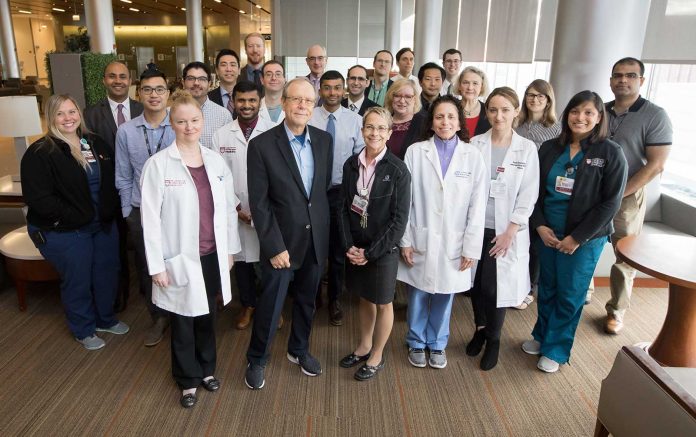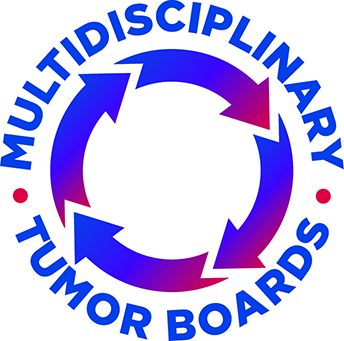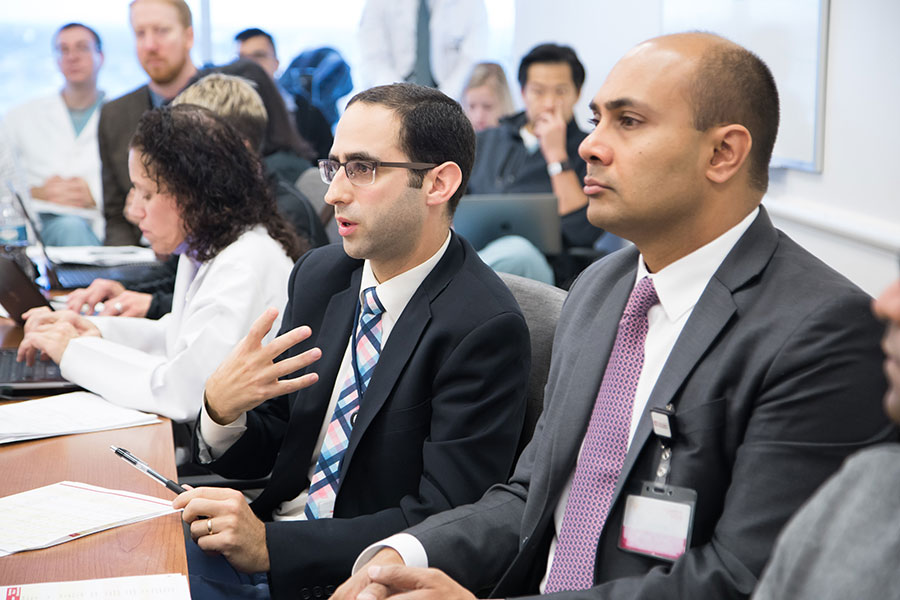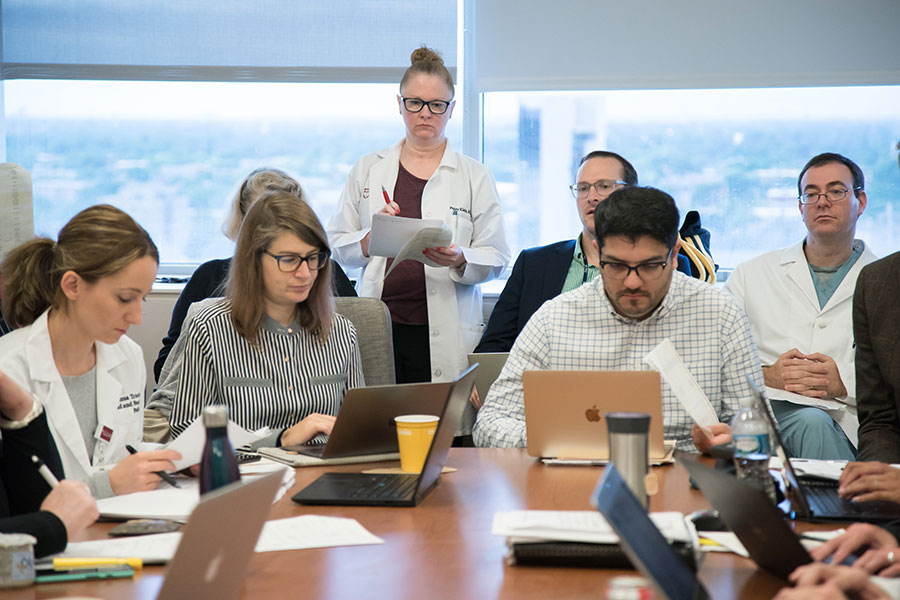
By Ari Rosenberg, MD
Posted: June 24, 2020
 As 7:00 AM approaches, the ninth-floor conference room slowly fills as team members file in and find their seats. The senior radiation oncologist identifies his seat in the front row, carefully placing his stack of index cards on the table before him, each identifying a patient’s pertinent history and treatment plan. Soon the room is packed with nurse navigators, clinical research coordinators, residents, fellows, medical oncologists, head and neck surgical oncologists, and radiation oncologists. The attending and resident radiologists sit at the mouse and keyboard to “drive” the Picture Archiving and Communication System on a large screen in the front of the room. Pathologists sit along the head of the table with a pathology resident. Fellows and residents sit in chairs along the back wall with laptop computers opened, poised to present their cases. Additional specialists such as neurosurgeons and laryngologists are often present as well. The coffee arrives, patient lists are distributed, and our weekly University of Chicago institutional tumor board begins. I hope that lessons derived from our multidisciplinary head and neck cancer tumor board can be applied broadly across tumor types treated with multimodality therapeutic approaches to better inform patient care.
As 7:00 AM approaches, the ninth-floor conference room slowly fills as team members file in and find their seats. The senior radiation oncologist identifies his seat in the front row, carefully placing his stack of index cards on the table before him, each identifying a patient’s pertinent history and treatment plan. Soon the room is packed with nurse navigators, clinical research coordinators, residents, fellows, medical oncologists, head and neck surgical oncologists, and radiation oncologists. The attending and resident radiologists sit at the mouse and keyboard to “drive” the Picture Archiving and Communication System on a large screen in the front of the room. Pathologists sit along the head of the table with a pathology resident. Fellows and residents sit in chairs along the back wall with laptop computers opened, poised to present their cases. Additional specialists such as neurosurgeons and laryngologists are often present as well. The coffee arrives, patient lists are distributed, and our weekly University of Chicago institutional tumor board begins. I hope that lessons derived from our multidisciplinary head and neck cancer tumor board can be applied broadly across tumor types treated with multimodality therapeutic approaches to better inform patient care.
Our tumor board begins with each of our head and neck surgeons presenting cases. Patient presentations are followed by imaging review, led by radiology, and pathology review, led by our pathologist colleagues. A discussion of optimal patient treatment ensues. Whereas some cases are resolved following swift and rapid agreement within the group, other cases trigger dissenting opinions and passionate exchanges back and forth. Post-operative case discussions include varied interpretations and perspectives on the data from multiple randomized studies and pooled analyses to inform management of a particular case. The interplay between the surgeon and the pathologist to understand the nuances of a particular surgical margin often allows the medical oncologist and radiation oncologist to determine the optimal adjuvant therapy or combined modality approach.

New patients are evaluated using a “triple-play” approach, with consultations from head and neck surgical oncologists, radiation oncologists, and medical oncologists, followed by presentation in our multidisciplinary forum prior to the initiation of definitive therapy. Even patients with head and neck cancers who ultimately are treated with upfront surgery undergo a multidisciplinary evaluation prior to surgical resection. The value of preoperative evaluation by radiation oncology is critical to postoperative management. Patients exhibit increased trust in their medical system when their treatment recommendation comes following a multidisciplinary discussion with a unified approach. Furthermore, patients appreciate meeting radiation oncologists and medical oncologists prior to surgery, as this improves their rapport with these specialties at the time of the postoperative discussion of adjuvant therapy. At our institution, this strategy also identifies potential candidates for our clinical trials. For example, patients with multiple recurrences of oral cavity cancer with premalignant changes are often identified in our tumor board as potential candidates for our institutional chemoprevention trial that randomly assigns patients to an immune checkpoint inhibitor versus placebo. The identification of candidates for institutional clinical trials is a critical role that our tumor board plays within our institution and program.
Recurrent and metastatic cases are commonly discussed and benefit from a multidisciplinary tumor board discussion. Input from our pathology colleagues in this setting is invaluable. We review not only the final histologic diagnosis but also discuss the results from our internal next-generation sequencing platform and our institutional RNA fusion panel. Biomarker evaluation, such as PD-L1 results, are also discussed. These discussions are used to differentiate metastatic disease from distinct separate primaries, which greatly affects prognosis and treatment. Targetable mutations and candidacy for biomarker-selected clinical trials are commonly an integral component of discussion.

In addition to practical and educational aspects, our tumor board includes a logistical component. Cases planned for chemoradiation will include a discussion between nurse navigators to coordinate the timing of scans, appointments, and treatments. Research activities routinely discussed at our multidisciplinary tumor board can range from determining clinical trial eligibilities to confirming radiographic response to treatment for patients on study. Our multidisciplinary tumor board tends to include a full agenda, with approximately 30 to 35 patients who are actively discussed each week; it routinely lasts up to one and a half hours.
In the era of COVID-19 and social distancing, our multidisciplinary tumor board successfully converted to a virtual format within 48 hours. We accomplished this using teleconferencing software with most participants joining by video and engaging in lively patient discussions. The radiologist and pathologist utilize “shared screen” features to facilitate imaging and pathology review of patients discussed. This format has allowed most elements of our in-person tumor board to thrive while maintaining safe and social distancing guidelines.
Although some components of our tumor board might be unique to our institution, I would suggest a number of key, generalizable observations for a successful tumor board:
- Multispecialty buy-in: Consistent representation across specialties is critical to tumor board success. Our tumor board begins once all specialties are represented.
- Tumor board list: Must include key elements such as name, medical record number, surgical specialist (if appropriate)/radiation oncology/medical oncology, age, diagnosis, and particular question for discussion (e.g., radiology, pathology, etc.).
- Preparation: Colleagues from radiology and pathology need to prepare for key cases a priori. Specific questions for discussion should be posed in advance to provide opportunity for adequate preparation.
- Education: Tumor boards are greatly enhanced by incorporation of educational cases. Some issue CME credit.
- Clear recommendations: Providing clear recommendations at the conclusion of each case discussion can be challenging, but it is critical to the tumor board’s success and to the continuity of patient care.
About the Author: Dr. Rosenberg is an assistant professor of medicine at The University of Chicago Medicine.










